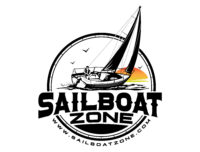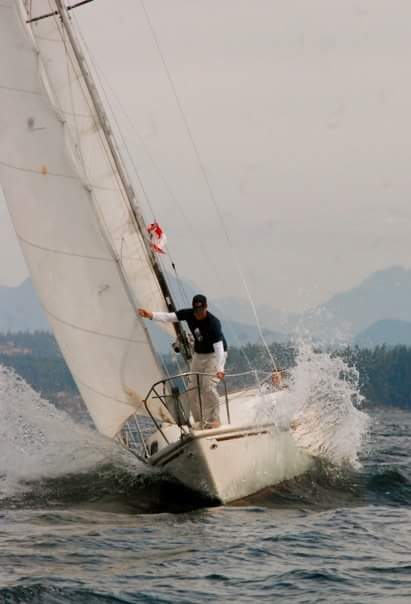Can a sailing sailboat tip over when it heels over? This is a question I hear a great deal. If it’s not asked of me directly, I certainly can see it in new sailor’s faces. Usually the first time under sail, and at the first big gust of wind! Everything appears under control. The sun, wind, and spray off the water invigorates and excites the crew. Then, all of a sudden a gust hits and the boat heels way over. There’s a panicked scream and the boat feels like it’s about to capsize!
Sailboats, when under wind power, just look unbalanced and susceptible to the wild forces of the wind. They rock back and forth so easily in the lightest waves. Visually, the center of gravity looks like it should be higher than it actually is. Sailboats appear very vulnerable to tipping. It is only natural to wonder if sailboats capsize, and to be intimidated by this reasonable possibility.
The following article deals with this. You will have an effective answer for yourself and for those who will inevitably ask you about this.
Generally speaking, sailboats that have a keel or are water ballasted, can not tip all the way over under normal sailing or cruising conditions. They can not flip upside down and, for the lion’s share of sailboats, they are actually self righting in the event of a “blowdown”.
The Keel is the Key!
There are physics equations I could quote to ease your mind. We are not going there. The short version is, the weight of the keel works in concert or in balance with the forces of the wind in the sails. Actually there is an intentional imbalance. The weight of the keel is engineered to win in the battle between gravity (the keel) and wind (the sails).
When a boat is under sail, the wind fills the sails and the boat leans over. This is referred to as “heeling”. Now, it is important to note here that the most efficient sailing is not when sailboats are heeled way over. I consider these kinds of sail setups over sailed, especially with the toe rail in the water. Many skippers feel that the larger the sail mass they have out, the faster the boat will go. Overpowering the boat is not the same as speeding up the boat. We are not talking about cars here.
When sails are properly selected and trimmed to the conditions, boats will heel over less. They will actually go faster! Sailing in high winds with properly selected sails, all properly trimmed, should yield a heel angle of 10 to 20 degrees. This condition is much safer and comfortable for the crew aboard. As a general rule, tbe a lot easier on your sails, your standing and your running rigging.
Heeling Over
Having too much sail out creates too much wind pressure, and thus overpowers the sailboat. This will cause the boat to heel over, sometimes uncomfortably. The skipper will be dealing with a great deal of weather helm (explained later). When the boat is heeled past comfort levels, and certainly past and uncomfortable 35 degrees (or more), an interesting phenomena happens.
First, and most obviously, the keel or ballast is also tilted towards the surface, out of its natural vertical position. This causes gravity to pull it (and the mast) back into this same vertical position. The other thing that happens is the sails and mast are also tilted way over, blown down, allowing a great deal of wind to spill out.
The further over a boat heels over, the more wind flows over or past the sails. With the wind spilling or blowing past a near horizontal sail, the wind has no power to keep the boat heeled over, let alone flipping the boat upside down. In this situation the boat will naturally right itself. If the boat has any forward momentum, then as the boat stands back up, the bow naturally veers directly into the wind. The term for this is “weather helm”.
You could maybe understand how a sailboat works by recognizing that sailing is finding a balance between overpowering weather helm (too much sail out), and too little sail out to power the boat.
All of the details above deal with regular cruising conditions that may get severe enough to trim sails, and at times may be deemed too extreme to sail in. The next section deals with extreme situations where capsizing is a real possibility.
All Boats Can Capsize
Yes that’s right, all boats can fall victim to the conditions and capsize. There are many anecdotes of sailors being blown down by a gale, but that is a temporary and extreme condition. Certainly not a situation a casual cruiser will or should get into. Usually these blow downs happen in storm like situations and the boat rights itself in short order.
Situations that could capsize a sailboat are the same situations that could capsize just about any other boat. If winds and gales are working against the sailboat, if there is far too much sail out, and if there are breaking waves as big or bigger than the sailboat all around, the conditions are prime for capsizing. Even in such conditions, where a boat has capsized, the keel of the sailboat can not remain turned up at the surface. The mast and sails will lay flat in the water, and gravity will pull the keel back down into a vertical position. This happens quite readily once the wind and wave energy abate, even for a moment.
If you ever find yourself in conditions such as these, your first order of defense against losing your boat is to close all hatches securely. Once your boat blows down, it is too late to take action. If you have a blowdown, or if you take a large wave into the cockpit during a blow down, you could very realistically flood the cabin and sink your boat if hatches are open.
Sailboats that WILL capsize regularly
There is another class of sailboat that can capsize, and that style of sailboat has a centerboard and not a heavy keel. There is no heavy counter-weight below the surface, like in a lead keel or water ballast style sailboat, and therefore no engineered righting solution in the event of an overpowering gust. If a gust comes and it is not properly mitigated by the skipper and crew, the boat will heel over, past its balance point, and the boat will partially turn over. This kind of boat is usually quite small, seats 2 or 3, and would be considered a day sailor.
These types of capsizing are not typically dangerous, but they are hard on boats. Stressing rigging in high wind is a recipe for wear on sails, masts, and damage to other components. Often these kinds of capsizing happen on purpose or as a result of overzealous risk taking during a race. Righting the boat is a simple, and relatively quick procedure.
The Most Stable Sailboat: The Catamaran
Another style of sailboat worth noting is the catamaran or trimaran style sailboats. These boats do not have a weighted keel that serves the same purpose or function compared to classic monohull sailboats. Instead, Catamarans are two hulled boats that have many unique advantages over traditional sailboats.
One advantage of the catamaran is its design that allows for shallow water sailing. Since there is no keel, like in a monohull boat, a catamaran can get into places that a monohull can not. Another advantage is that Catamarans are about as wide as they are long, which makes them spectacularly stable in just about any conditions.
When it comes to heeling over, a catamaran will generally get to about 10 degrees before sail adjustments and reefing are needed. Catamaran sailors are not usually concerned with tipping over. The concern that rides far above capsizing in high winds is the risk of breaking running rigging or other components because there is too much sail out.
How to handle a blow down
In the event your cruiser is involved in a blow down, remain calm. Give yourself a moment and take stock of the situation. What will immediately come to mind is the realization that you have too much sail out. If there is a reprieve in the gust, the keel will stand the boat back up. The bow will then veer upwind, effectively turning your sails into a flag. You will be “in irons” as they say. It is imperative at this stage that you reduce sail quickly.
The flapping of sails and sheets will be intimidating and admittedly dangerous. Take great care in your next steps. When possible, douse (lower) the jib as quickly as possible. If this is not possible, have your helmsman remain in the cockpit and point the boat directly into the wind. I would suggest powering up the motor so that you can maintain steering. Once again, the object at this point is to reduce sail. With the boat firmly held in irons, take in the sheet of the main. At least it is under control and not whipping at the mercy of the wind. Once confidence is restored that you are in control of your boat, take steps to douse the jib, then the main sail.
In conditions that can blow your boat down, you need to admit to yourself that you may be in over your head. Drop your sails and proceed under power. Should you decide that sailing is still your preferred choice, it is time to bend on a storm jib for the time being and head down wind while you lick your wounds. This small sail will allow you to use the extreme forces of the wind to provide forward movement. It will not be so much sail as to threaten another blow down. If heading upwind, you will also want to reef your main as small as it will reef. This is a difficult and dangerous process in winds that can potentially blow you down. The main is your only chance of upwind sailing, if that is your only option.
Conclusion
So to sum up, if sailing interests you, yet you have the fear of tipping all the way over, I hope you have found some comfort in the principles outlined above. Sailboats designed for comfort and cruising are usually designed to be sailed responsibly and within design parameters. They will not capsize under “normal” sailing conditions. That being said, it is the skipper who is responsible for ensuring the sailboat he pilots is appropriately set up for conditions. This means preparing and planning for the weather of the day. It means being observant and responsive to changing weather conditions (ie. correct sail choice). And it also means knowing when to pack it all up and head back to the marina if there’s just too much wind to manage.

